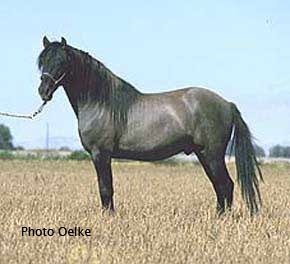SORRAIA TYPES AND NON-SORRAIA TYPES IN ONE FAMILY?
Because one may find horses of Sorraia type and others of a different type within one and the same mustang family, it's been claimed that this would suggest that Sorraia types among mustangs are freak occurences. Whether or not this phenomenon actually exists is a question we won’t address here. If so, it can easily be explained. It’s a simple question of inheritance.
If one observes, for instance, how full siblings of a human family can be different in appearance, abilities, traits, etc., one won't find it unusual for full siblings of horses to differ. The human example is used here as it's usually easier to observe, because not too often does a person get to know many fully mature siblings of horses. Those who indeed get the chance to study many full siblings of horses will notice how different they can be.
That’s not the whole answer, though. The more mixed a given breed is, the more likely are foals to be different, even if they are full siblings. With wild species, the parents, grandparents, great-grandparents, etc., were all of the same type, so they breed true. If the parents are a mixture, maybe even a mixture of extremes, their foals naturally will be a wide variety of types and colors. The Spanish mustang breeders and registries have been mixing different types, sometimes even extremes, right from the beginning. And by now they've done this for many generations… It's really no wonder if sometimes foals of the same mating are not uniform.
Silvertip F52 is out of Mountain Mist F15, which is out of Mexi con Estrella, and a full brother and half brother to a number of other SMS-registered horses
"Like begets like" is an old saying among horse breeders. That's how you establish type, that's how you establish uniformity. Like begets like is what happens with wild species out there every day. Mustang registries allow for crossing of dish-faced, Arab-type mustangs and convex-headed, Sorraia-types, and then in the next generation there may be a cross on a compact pony type, or a draft type (yes, even those are part of the whole thing). The offspring of all these crosses are bound to breed inconsistently.
There have been some zoological experiments that shed some light on this: For instance, in a wolf x poodle cross, the first litter consisted of mostly dogs that were, in phenotype, an even mixture of both, wolf and poodle. However, when these siblings were again crossed on each other, they produced only a few that looked like that mixture – the genes started to split up again, and most of the results were either more like wolves or more like a poodle in type and color...
This is what happened and still happens with mustangs, too. Types split up and crop out. Now we’re getting to an interesting and important aspect: Those wolf-dogs of the latter generations that looked pretty much like wolves didn't do so by chance – it was the wolf genes that cropped out! Now if one had mated only those and continued to select the wolf types, one could have arrived at animals within a few generations that resembled pure wolves to a high degree, and they would indeed have very little poodle in them at all...
Going back to mustangs, the Sorraia genes are still present in the Spanish Mustang population, more in some horses, less in others – but they do crop out. Is a horse with Sorraia characteristics worthless to the preservation of the Sorraia Mustang, should it be ignored, just because it has a sister or brother that differs somewhat in conformation and/or color? On the contrary! The sensible and responsible thing to do is to mate such horses with others of the same type, or even better type, and thus re-establish and reinstate what is about to get lost!
That’s what the Sorraia Mustang Studbook is all about.

